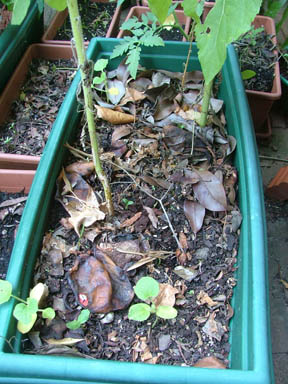I'm growing lots of vegetables, despite the water restrictions and depite the fact that I have moved house over 3 times
this year.
How?
I grow most of them in pots, using permaculture principles.

What is permaculture?
Permaculture means permanent agriculture, a type of agriculture that mimics nature by designing an interdependent ecosystem.
It was developed in Australia as an alternative to industrial agriculture, yet it is similar to types of agriculture developed
over thousands of years by indigenous people around the world.
Improving the soil
The most important consideration in growing strong vegetables is improving the soil, by encouraging insects and microorganisms
to live in it, and by growing legumes to improve the Nitrogen content of the soil.
Compost and mulch are key here. I have a worm farm, which eats up our kitchen and garden waste, leaving soil that is full
of activity (and remnant vegetable seeds). I regularly distribute broken down compost on the vegetable garden.
Mulch is different to compost, in that its primary purpose is to shield the surface of the soil from the drying of the sun,
and the erosive power of rain. It is usually made up of partially broken down leaves or lawn clippings, or hay, and forms
the top-most layer of the soil. Well mulched plants need a lot less water than other plants, because they don't dry out as
easily.

To improve the Nitrogen content of the soil, for the benefit of leafy plants such as lettuce, I plant beans (in Summer)
and peas (in Winter) everywhere. The bacteria associated with the roots of legumes fix Nitrogen from the air, and convert
it into a useable solid form in the soil. Here is a photo of some bean flowers and baby beans:


